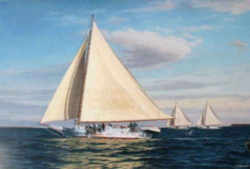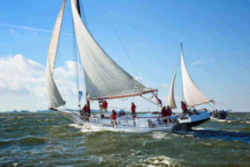Maryland State Boat
Skipjack

Adopted in 1985
The skipjack became the State Boat in 1985 (Chapter 788, Acts of 1985; Code State Government Article, sec. 13-312).
The skipjack is a traditional fishing boat used on Chesapeake Bay for oyster dredging. It is a sailboat which succeeded the bug eye as the chief oystering boat on the bay, and remains in service due to laws restricting the use of powerboats in the Maryland state oyster fishery.
Maryland State Boat: Skipjack

The name, skipjack, is taken from fish (such as skipjack herring, skipjack mackeral, skipjack tuna) that leap in and out of water, and play on the water's surface. With a reputation for speed, skipjacks sometimes can resemble the fish as they come about quickly making continuous passes or "licks" over oyster beds.
On Maryland's Eastern Shore, the skipjack originated in the 1890s. It was better known as a small "two-sail bateau" with a V-hull. The craft evolved into a larger, hearty skipjack, powerful in light winds. Ranging in length from 25 to 50 feet, these boats have a shallow draft with centerboard and carry a single mast, two-sail sloop rig.
Skipjacks are the last working boats under sail in the United States. In winter, fleets of skipjacks used to dredge oysters from the floor of Chesapeake Bay. "Drudgin," as watermen called this process, was hard, cold, dirty, sometimes dangerous work.
The skipjack arose near the end of the 19th century. Dredging for oysters, prohibited in 1820, was again made legal in 1865. Boats of the time were
unsuitable, and the bugeye developed out of the log canoe in order to provide a boat with more power adapted to the shallow waters of the oyster beds.
The bugeye was originally constructed with a log hull, and as the supply of appropriate timber was exhausted and construction costs rose, builders
looked to other designs. They adapted the sharpies of Long Island Sound by increasing the beam and simplifying the sail plan. The result was cheaper
and simpler to construct than the bugeye, and it quickly became the predominant oystering boat in the bay.
Debate remains to this day about the origins of the name. Some speculate it came from a name New England fisherman called the flying fish, bonita.
Still others claim it is derived from an archaic English term, meaning an "inexpensive yet useful servant."
Maryland's oyster harvest reached an all-time peak in 1884, at approximately 15 million bushels of oysters. The oyster harvest has since declined steadily,
especially at the end of the 20th century. The size of the fleet has likewise declined. New skipjacks were built as late as 1993, but a change in the
law in 1965 allowed the use of motor power two days of the week. As a result, few of the boats are operated under sail in commercial use; instead,
a pushboat is used to move the skipjack, and little dredging is done except on the days that power is allowed.
At one time, the number of skipjacks produced is estimated at approximately 2,000; today, they number about 40, with less than half of them in active
fishing. The future of the fleet remains in doubt as efforts continue to restore the productivity of the oyster beds.
The skipjack was designated the state boat of Maryland in 1985.
Maryland Law
The law designating the Skipjack as the official Maryland state boat is found in the Maryland Statutes, Title 13, Section 13-312.
STATE GOVERNMENT
§ 13-312 - Boat
Universal Citation: MD State Govt Code § 13-312 (2013)
§13-312.
The Skipjack is the State boat.








